Edtech revenue streams and pricing: The Entrepreneur'sGuide to Edtech Revenue Models
1. what is edtech and why is it a booming industry, 2. how do edtech companies make money from their products and services, 3. how do edtech companies set the right price for their target market and value proposition, 4. what are the common types of edtech revenue models and how do they differ, 5. how do some of the leading edtech companies use different revenue models to achieve success, 6. how can you optimize your revenue model to maximize your growth and profitability, 7. how to choose the best revenue model for your edtech business and what are the key takeaways from this blog.
The education sector has undergone a significant transformation in the past decade, thanks to the emergence and adoption of various technologies that enable new ways of learning, teaching, and delivering educational services. This phenomenon, known as edtech, or education technology, encompasses a wide range of products, platforms, and solutions that leverage digital tools and innovations to enhance the quality, accessibility, and affordability of education.
Edtech is not a new concept, but it has gained unprecedented momentum and popularity in recent years, especially in the wake of the COVID-19 pandemic, which disrupted the traditional modes of education and forced millions of students and educators to shift to online and remote learning . According to a report by HolonIQ, the global edtech market size was estimated at $227 billion in 2020, and is projected to grow to $404 billion by 2025, at a compound annual growth rate (CAGR) of 16.3%.
The growth of edtech is driven by several factors, such as:
1. The increasing demand for personalized and adaptive learning , which allows students to learn at their own pace, style, and level of proficiency, and provides teachers with real-time feedback and data to tailor their instruction and interventions accordingly. Examples of edtech products that enable personalized and adaptive learning include Knewton , DreamBox Learning , and Duolingo .
2. The rising need for lifelong and continuous learning, which reflects the changing nature of work and skills in the 21st century, and the desire of individuals to acquire new knowledge and competencies throughout their careers. Examples of edtech products that facilitate lifelong and continuous learning include Coursera , Udemy , and LinkedIn Learning .
3. The expanding access and affordability of education, which means that more people, especially in developing and emerging markets, can benefit from high-quality and relevant educational opportunities, regardless of their location, income, or background. Examples of edtech products that improve access and affordability of education include Khan Academy , Byju's , and Bridge International Academies .
4. The evolving pedagogy and curriculum, which involves the integration of new subjects, skills, and methods of teaching and learning, such as STEM (science, technology, engineering, and mathematics), coding, gamification, and project-based learning . Examples of edtech products that support the evolving pedagogy and curriculum include Scratch , Minecraft Education Edition , and Classcraft .
These factors, along with the rapid advancement and innovation of technology, create a huge potential and opportunity for edtech entrepreneurs, who can leverage various revenue streams and pricing models to monetize their products and services, and create value for their customers and stakeholders. In the following sections, we will explore some of the most common and effective edtech revenue streams and pricing models, and provide examples and best practices for each one.

Explore how to build your tech startup
FasterCapital works with you on creating a successful tech startup and covers 50% of the costs needed per equity!
One of the most important decisions that edtech entrepreneurs have to make is how to generate revenue from their products and services . There are many different ways to monetize edtech solutions, depending on the target market, the value proposition, the competitive landscape, and the customer needs and preferences. In this section, we will explore some of the most common and effective revenue streams for edtech companies, as well as the advantages and disadvantages of each one. We will also provide some examples of successful edtech startups that have adopted these revenue models and how they have scaled their businesses.
Some of the most popular revenue streams for edtech companies are:
1. Subscription : This is a recurring fee that customers pay to access the edtech product or service for a certain period of time , usually monthly or annually. Subscription models are suitable for edtech solutions that offer continuous value, such as online courses, learning platforms, or adaptive software. subscription models can create a steady and predictable income stream for edtech companies, as well as increase customer loyalty and retention . However, subscription models also require a high level of customer satisfaction and engagement , as well as a low churn rate. Some examples of edtech companies that use subscription models are Coursera, Duolingo, and Khan Academy.
2. Freemium : This is a combination of free and premium offerings, where customers can access some features or content for free, but have to pay for additional or advanced features or content. Freemium models are effective for edtech solutions that have a large potential user base, as well as a clear differentiation between the free and premium tiers. Freemium models can help edtech companies acquire and retain customers , as well as generate word-of-mouth and referrals . However, freemium models also entail a high cost of serving free users, as well as a low conversion rate from free to paid users. Some examples of edtech companies that use freemium models are Quizlet, Codecademy, and Udemy.
3. Transaction : This is a one-time or occasional fee that customers pay to access or purchase the edtech product or service. Transaction models are suitable for edtech solutions that offer discrete or consumable value, such as ebooks, test prep, or tutoring. Transaction models can generate a high profit margin for edtech companies, as well as a low customer acquisition cost . However, transaction models also imply a low customer lifetime value, as well as a high dependency on customer demand and seasonality. Some examples of edtech companies that use transaction models are Chegg, Knewton, and MasterClass.
4. Advertising : This is a revenue stream that comes from displaying ads to the customers or users of the edtech product or service. Advertising models are applicable for edtech solutions that have a large and active user base , as well as a high level of user engagement and data. Advertising models can provide a passive and scalable income stream for edtech companies, as well as a low barrier to entry for customers or users. However, advertising models also pose a risk of compromising the user experience and trust , as well as a low control over the ad quality and relevance. Some examples of edtech companies that use advertising models are YouTube, Edmodo, and Brainly.
How do edtech companies make money from their products and services - Edtech revenue streams and pricing: The Entrepreneur'sGuide to Edtech Revenue Models
One of the most crucial decisions that edtech entrepreneurs face is how to price their products or services . Pricing is not only a reflection of the value that the edtech company provides to its customers, but also a determinant of its revenue potential, profitability, and competitive advantage. However, pricing is not a one-size-fits-all process. Edtech companies need to consider various factors such as their target market, value proposition, cost structure, revenue model, and competitive landscape when setting their prices. In this section, we will explore some of the common pricing strategies that edtech companies use and how they align with their business goals and customer needs.
Some of the common pricing strategies that edtech companies use are:
- Cost-plus pricing : This is the simplest and most straightforward pricing strategy, where the edtech company adds a fixed percentage or amount of profit margin to the total cost of producing or delivering its product or service. For example, if an edtech company offers an online course that costs $100 to produce and deliver, and it wants to earn a 20% profit margin, it will charge $120 for the course. This pricing strategy is easy to implement and ensures that the edtech company covers its costs and earns a profit. However, it does not take into account the value that the product or service provides to the customers or the demand and competition in the market. It may result in overpricing or underpricing the product or service, which can affect the sales and customer satisfaction .
- Value-based pricing : This is a more customer-centric pricing strategy, where the edtech company sets its price based on the perceived value that its product or service provides to the customers. For example, if an edtech company offers a personalized learning platform that helps students improve their academic performance and confidence, it will charge a price that reflects the benefits and outcomes that the students can achieve by using the platform. This pricing strategy is more effective in capturing the customer's willingness to pay and creating a loyal customer base . However, it requires a deep understanding of the customer's needs, preferences, and pain points, as well as a clear communication of the value proposition and differentiation of the product or service. It may also be challenging to quantify and measure the value that the product or service delivers, especially for intangible or long-term benefits .
- Competitive pricing : This is a more market-oriented pricing strategy, where the edtech company sets its price based on the prices of its competitors or substitutes in the market. For example, if an edtech company offers a gamified learning app that competes with other similar apps in the market, it will charge a price that is comparable or lower than the prices of its competitors. This pricing strategy is useful in attracting and retaining customers who are price-sensitive or who compare different options before making a purchase decision. However, it does not reflect the unique value or quality of the product or service , and it may lead to a price war or a race to the bottom, which can erode the profit margins and brand image of the edtech company.
- Dynamic pricing : This is a more flexible and adaptive pricing strategy, where the edtech company adjusts its price based on the changes in the market conditions , customer behavior, or product availability. For example, if an edtech company offers a live tutoring service that matches tutors and students based on their availability and preferences, it will charge a price that varies depending on the supply and demand of tutors and students, the time of the day, the level of difficulty, or the duration of the session. This pricing strategy is efficient in optimizing the revenue and utilization of the product or service, as well as catering to the different segments and needs of the customers. However, it requires a sophisticated and data-driven pricing algorithm and system, as well as a transparent and fair pricing policy and communication with the customers. It may also create confusion or dissatisfaction among the customers who may perceive the price fluctuations as unfair or arbitrary.
One of the most critical decisions for any edtech entrepreneur is how to generate revenue from their product or service . There are many different types of edtech revenue models , each with its own advantages and disadvantages, depending on the target market, value proposition, customer behavior, and competitive landscape. In this section, we will explore some of the common types of edtech revenue models and how they differ in terms of pricing, scalability, customer acquisition, retention, and satisfaction.
Some of the common types of edtech revenue models are:
- Subscription : This model involves charging customers a recurring fee , usually monthly or annually, to access the edtech product or service. The subscription model is attractive for edtech entrepreneurs because it provides a predictable and stable source of revenue, encourages customer loyalty, and allows for cross-selling and upselling opportunities . However, the subscription model also requires a high level of customer satisfaction, retention, and engagement, as well as a low churn rate. Additionally, the subscription model may face competition from free or low-cost alternatives, especially in emerging markets where customers may be more price-sensitive. Examples of edtech companies that use the subscription model are Coursera , Duolingo , and MasterClass .
- Freemium : This model involves offering a basic version of the edtech product or service for free, and charging customers for additional features, content, or functionality. The freemium model is effective for edtech entrepreneurs because it lowers the barrier to entry for customers, increases the user base, and creates a network effect. Moreover, the freemium model can leverage the data and feedback from the free users to improve the product or service and tailor it to the needs and preferences of the paying customers. However, the freemium model also poses some challenges, such as finding the right balance between the free and premium offerings, converting free users to paying customers , and maintaining the quality and value of the product or service. Examples of edtech companies that use the freemium model are Khan Academy , Quizlet , and Codecademy .
- Transaction : This model involves charging customers a one-time or per-use fee for accessing the edtech product or service. The transaction model is suitable for edtech entrepreneurs who offer a high-value, low-frequency, or niche product or service that customers are willing to pay for on demand. The transaction model can also benefit from word-of-mouth marketing , referrals, and reviews, as well as from creating a sense of urgency and scarcity for the product or service. However, the transaction model also has some drawbacks, such as a high customer acquisition cost, a low customer lifetime value, and a high dependency on the quality and reputation of the product or service. Examples of edtech companies that use the transaction model are Udemy , Skillshare , and Chegg .
- Advertising : This model involves generating revenue from displaying ads to the users of the edtech product or service. The advertising model is appealing for edtech entrepreneurs who have a large and diverse user base , a high level of user engagement, and a rich source of user data. The advertising model can also create a positive feedback loop , as more users attract more advertisers, and more advertisers attract more users. However, the advertising model also faces some challenges, such as maintaining the user experience , privacy, and trust, as well as competing with other platforms and channels for ad revenue. Examples of edtech companies that use the advertising model are YouTube , TED-Ed , and Brainly .
One of the most important decisions for any edtech entrepreneur is how to generate revenue from their product or service. There is no one-size-fits-all solution, as different edtech companies may have different target markets, value propositions, cost structures, and competitive advantages. However, by looking at some of the leading edtech companies in the world, we can identify some common revenue models that they use to achieve success. These include:
- Subscription : This is a model where users pay a recurring fee, usually monthly or annually, to access the edtech product or service. This model provides a steady and predictable income stream for the edtech company, as well as a strong incentive to retain and engage users. However, it also requires a high level of customer satisfaction and loyalty , as well as a clear differentiation from other alternatives. Some examples of edtech companies that use this model are Coursera , Duolingo , MasterClass , and Quizlet .
- Freemium : This is a model where users can access a basic version of the edtech product or service for free, but have to pay for additional features, content, or benefits. This model allows the edtech company to reach a large and diverse user base, as well as to showcase the value of their product or service . However, it also requires a careful balance between the free and paid offerings, as well as a clear communication of the value proposition and benefits of upgrading. Some examples of edtech companies that use this model are Khan Academy , Codecademy , Udemy , and Edmodo .
- Advertising : This is a model where users can access the edtech product or service for free, but are exposed to ads from third-party advertisers. This model enables the edtech company to monetize their large and active user base, as well as to offer a low-cost or no-cost option for users. However, it also requires a high level of user engagement and retention , as well as a careful management of the user experience and privacy. Some examples of edtech companies that use this model are YouTube , TED-Ed , Brainly , and Chegg .
- Transaction : This is a model where users pay a one-time or per-use fee to access the edtech product or service. This model allows the edtech company to generate revenue from each user interaction, as well as to offer a flexible and convenient option for users. However, it also requires a high level of user demand and satisfaction, as well as a competitive pricing strategy . Some examples of edtech companies that use this model are Skillshare , Udacity , Lynda , and Byju's .
One of the most crucial decisions for any edtech entrepreneur is how to design and optimize their revenue model. A revenue model is the way a business generates income from its products or services. It defines who pays, how much, when, and for what value proposition. A well-designed revenue model can help an edtech business achieve sustainable growth and profitability, while a poorly designed one can hinder its success or even lead to its failure.
There are many factors that influence the choice and optimization of a revenue model, such as the target market, the customer segments, the value proposition, the cost structure, the competitive landscape, and the regulatory environment. However, there are some general best practices that can guide edtech entrepreneurs in this process. Here are some of them:
- 1. Align your revenue model with your value proposition. Your revenue model should reflect the value that you deliver to your customers and how they perceive it. For example, if your value proposition is based on providing personalized learning experiences , you might want to charge a subscription fee that varies according to the level of customization and support that each learner receives. On the other hand, if your value proposition is based on providing access to high-quality content, you might want to charge a one-time fee or a pay-per-use fee that depends on the amount and type of content that each learner consumes.
- 2. Experiment with different revenue streams and pricing strategies. There is no one-size-fits-all revenue model for edtech businesses. You might need to test and iterate different revenue streams and pricing strategies to find the optimal combination that maximizes your revenue and profitability. For example, you might want to try a freemium model, where you offer a basic version of your product or service for free and charge for premium features or add-ons. Or you might want to try a bundling model, where you offer a package of products or services for a discounted price . Or you might want to try a dynamic pricing model , where you adjust your prices according to the demand , supply, or other factors.
- 3. Understand your customers' willingness and ability to pay. Your revenue model should match your customers' preferences and expectations regarding how and how much they pay for your product or service . You should conduct market research and customer interviews to understand your customers' willingness and ability to pay, as well as their sensitivity to price changes. For example, you might want to segment your customers based on their income level, education level, location, or other criteria, and offer different pricing options or discounts to each segment. Or you might want to use a value-based pricing strategy, where you charge based on the perceived value or the outcomes that your product or service delivers to your customers.
- 4. Monitor and analyze your revenue performance and customer behavior. Your revenue model should be constantly evaluated and improved based on the data and feedback that you collect from your revenue performance and customer behavior . You should use metrics and indicators such as revenue growth, revenue per customer, customer acquisition cost, customer lifetime value, customer retention rate , customer satisfaction, and customer churn rate , to measure and optimize your revenue model. You should also use analytics and insights tools to understand how your customers use your product or service , what features or benefits they value the most, what pain points or challenges they face, and what opportunities or suggestions they have for improvement.
Get closer for securing your needed capital
FasterCapital helps you in getting matched with angels and VCs and in closing your first round of funding successfully!
choosing the best revenue model for your edtech business is not a one-size-fits-all decision. It depends on various factors such as your target market, value proposition, customer acquisition cost, retention rate, and scalability potential. In this blog, we have explored some of the most common and effective edtech revenue streams and pricing strategies, such as:
- Subscription : Charging a recurring fee for access to your product or service. This model can generate predictable and consistent revenue, but it requires a high level of customer satisfaction and loyalty. Examples: Coursera, Duolingo, Skillshare.
- Freemium : Offering a basic version of your product or service for free, and charging for premium features or content. This model can attract a large user base and increase brand awareness , but it can also create a low conversion rate and high churn rate. Examples: Khan Academy, Quizlet, Udemy.
- Advertising : displaying ads on your platform or content, and earning revenue from advertisers based on impressions, clicks, or conversions. This model can be a low-cost and scalable way to monetize your audience, but it can also compromise the user experience and the quality of your product or service. Examples: YouTube, Spotify, Medium.
- Sponsorship : Partnering with a third-party organization or individual who pays you to promote their brand, product, or service on your platform or content. This model can create a win-win situation for both parties , but it can also pose a risk of losing credibility and trust with your audience. Examples: TED-Ed, Code.org, MasterClass.
- Affiliate : Recommending or endorsing a third-party product or service on your platform or content, and earning a commission for each sale or referral. This model can create a passive income stream, but it can also require a lot of effort and research to find relevant and quality products or services . Examples: Amazon Associates, Teachable, Skillshare.
- Licensing : Granting a third-party organization or individual the right to use your product or service for a fixed fee or a royalty. This model can create a steady and long-term revenue stream, but it can also limit your control and innovation over your product or service . Examples: Rosetta Stone, Pearson, McGraw-Hill.
The key takeaways from this blog are:
- There is no single best revenue model for edtech businesses. You need to consider your goals, value proposition, market size, customer behavior, and competitive advantage.
- You can also combine or experiment with different revenue streams and pricing strategies to optimize your revenue potential and customer satisfaction.
- You need to constantly monitor and measure your revenue performance and customer feedback , and adjust your revenue model accordingly.
Professional business development services for your startup
FasterCapital provides various types of business development and becomes your long-term growth partner
Read Other Blogs
In the realm of time consciousness, the concept of time sensitivity plays a pivotal role in shaping...
Storytelling has emerged as a powerful tool in the realm of business presentations, particularly...
In the realm of developmental disorders, a particular subset of individuals presents with a unique...
Matrix multiplication, commonly referred to by its function name in many spreadsheet applications,...
1. The Essence of Margins: Margins lie at the heart of any business operation....
Brainstorming in design is a dynamic and collaborative process that serves as the backbone of...
In the realm of Instagram marketing, the unveiling of a new product is a pivotal moment that can...
In the landscape of business analytics, the phenomenon of customers discontinuing their...
Social enterprises are businesses that pursue a social or environmental mission alongside...
Happy Hour: Growing your consumer subscription business
Choosing the right revenue model for your edtech business
Oct 25, 2021

Chloe Dormand

Join our newsletter for the latest in SaaS
By subscribing you agree to receive the Paddle newsletter. Unsubscribe at any time.
In 2020, the edtech industry went from one-to-watch to a booming, mainstream channel in the traditional education system. As global lockdowns halted face-to-face learning in schools and universities, and many adults had more time at home to learn something new, edtech provided the flexibility and remote access to education that the world needed.
And the numbers speak for themself:
- The global edtech market grew by 22% in Q1 of 2020
- It is forecast to grow on average 19.9% a year through 2027
What does this rapid growth mean for edtech now and how can you set your business up for success?
For one, it means trying to stand out in an increasingly competitive market. And if you do win out against the competition, you need to have scalable systems in place to support you as you grow.
Underpinning all of this is how you bring revenue into your business. And with a number of models to choose from, finding the right one for your business is more crucial than ever.
In this guide, we unpack some of the most popular SaaS revenue models for edtech businesses and discuss the pros and cons of each.
Choosing the right revenue model
The right model for your business will depend on a number of different factors, including:
- The customers you serve . Different types of customers have different buying habits so think about who exactly you’re targeting. Is it consumers, educational institutions, or someone else? If institutions, are they privately funded or run by a local authority?
- Where your customers are based: Different revenue models are more popular in different regions. Some countries also have different regulations regarding sales tax on software and security on recurring payments that should inform your decision.
- The product or service you are selling: Is this something you expect people to use on an ongoing basis? Or is it more suited to a one-off purchase?
- Your business stage and growth plans: If your main focus is getting more users (customer acquisition) your revenue model should support that and help you get people through the door (this might be free users at first). Whereas a business focused on retaining its current customer base might put the resource into optimizing a subscription model.
5 SaaS revenue models
Here are five popular SaaS revenue models that successful Edtechs are already using:
1. Freemium model
A freemium model is where you offer a free version of your product or service. One that has enough features to show the users the value of your product but is limited enough to encourage users to upgrade later on.
It’s a model tried and tested by SaaS giants like Zoom, and Slack. Think back to having to start a new meeting after 40 minutes of that virtual quiz - or was that too annoying, making you sign up for the unrestricted times of a Pro Package? See what they did there?
It’s a great way to get more people using your product and stand out against your competitors if they don’t offer a free version of their own.
By giving customers access to your product for free, they can see for themselves just how valuable it will be to them.
A freemium model can help you retain customers for longer. As users already know what they’re going to be paying for, there should be less cause to churn .
Using a freemium model means carefully treading a fine line between offering a valuable free service and persuading users that your full product is actually worth paying for.
If your free users aren’t left wanting more, they’ll stick with what they’ve got. Yet if your free version isn’t up to scratch, you risk losing them altogether.
For edtechs selling to schools or other institutions with a tighter budget in particular, it’s important to think about how exactly you will convert your free users before you opt for that freemium model. Here are some tried and tested techniques to get you started .
2. Ad-based model
An ad-based model involves monetizing your product through ad space on your product or platform, rather than charging your users. It’s commonly used alongside a freemium model.
Perhaps most famously, Spotify has successfully used this model for a long time by playing ads in between the media its free users are listening to.
In the edtech world, language-learning app Duo-lingo has taken this model to the masses with 40million active learners split between its free and paid offerings.
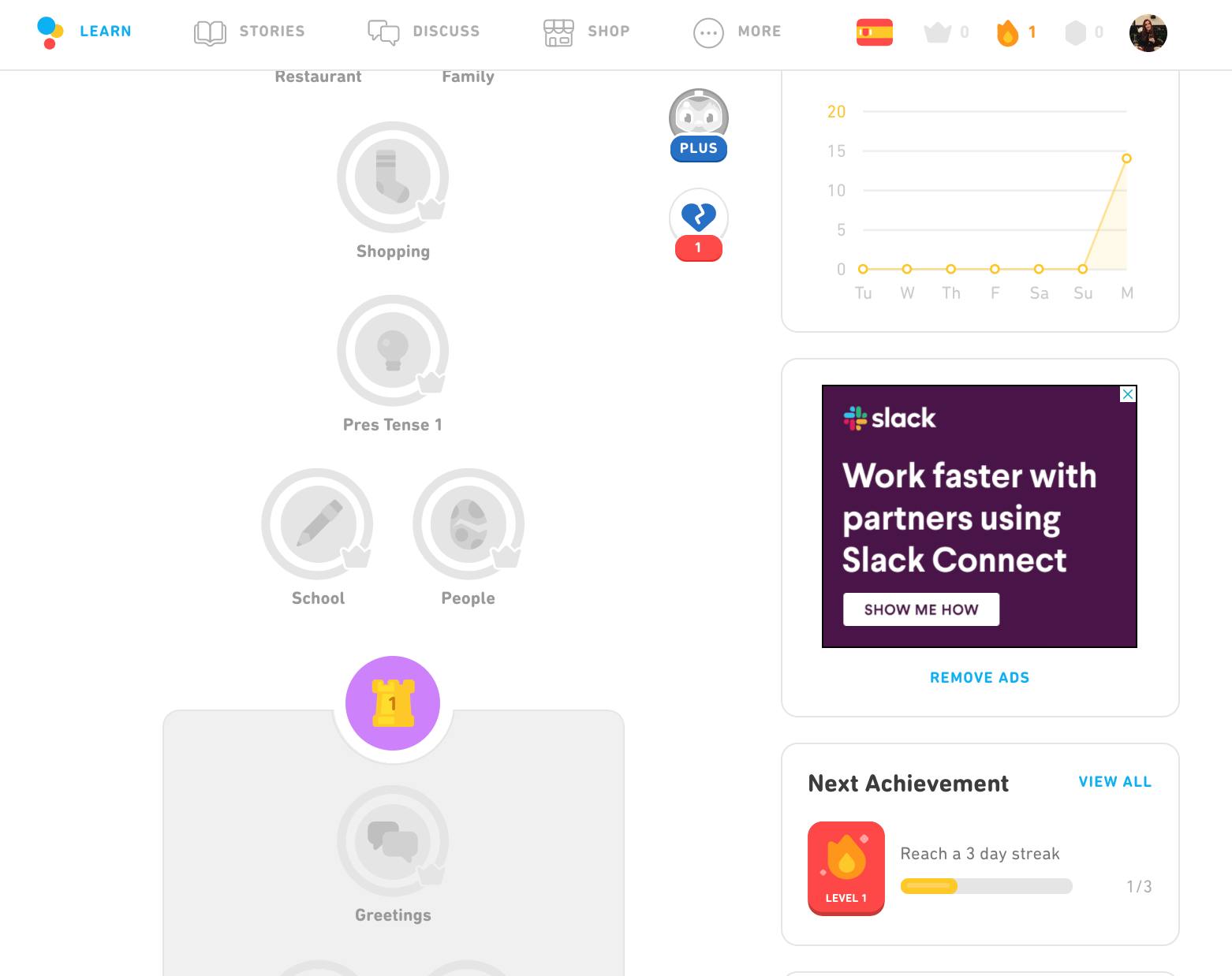
You can still make money from a free version of your product. This means you’re likely to be able to keep that version free long term, without it blocking your growth.
Adverts can be a catalyst for users moving to a paid subscription. Particularly for media or learning platforms where adverts interrupt the experience.
You need to make sure that the advertising doesn’t stop users from wanting to use your product. We’ve all used an app with too many ads and swiftly deleted it.
You need a strategy for filling the ad space, either directly or through a third-party tool. And even when you have them, you won’t see the revenue rolling in right away. For ads to be worthwhile, you’ll need to make sure there are a lot of eyes on them - and in many cases, clicks and interactions too.
3. Subscription model
If your product is intended for long-term use, then you’ve probably already considered using a subscription model. That is charging your customers on a recurring basis, often monthly or annually.
It’s a model that became popular with media and entertainment services but has since boomed - and you can now buy everything from your weekly meals to beauty products on a subscription basis. And, of course, your edtech too.
DuoLingo has Duolingo Plus, which starts with a full access 14-day trial before moving to a monthly payment. Others, like Kahoot! have a number of different paid packages for individuals and teams - before moving to bespoke pricing for enterprise businesses.
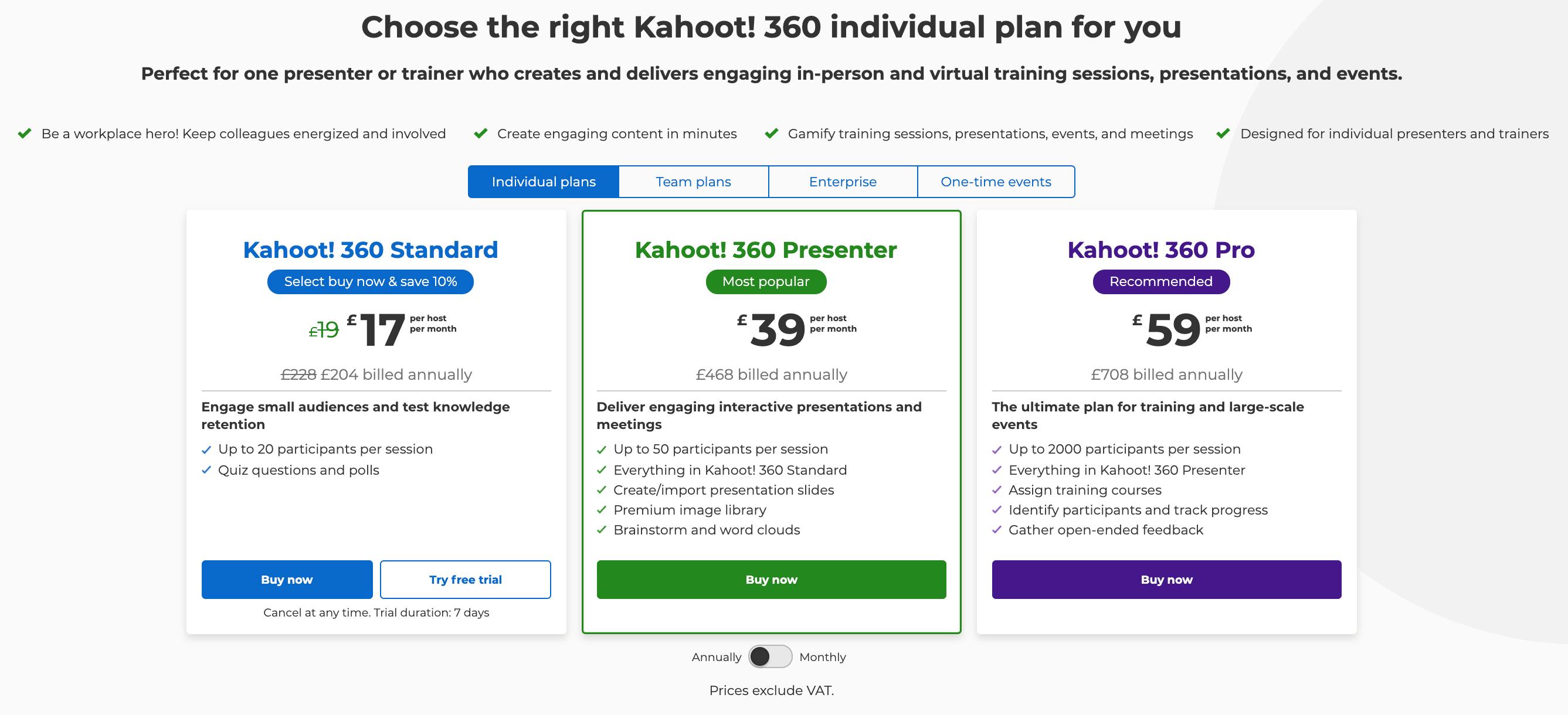
Subscriptions are flexible and allow you to package your product in a way that’s most effective for your business and customers.
Recurring payments give you a more predictable source of revenue and (hopefully) a loyal customer base for potential upsells or add-ons later down the line.
You need the technology to manage recurring payments and subscription logic. That’s finding a payment gateway and a subscription management tool (and integrating them together) or working with an all-in-one solution. Whichever way you choose to manage that infrastructure, the subscription process should be seamless for the customer, otherwise you risk customer churn .
4. Marketplace model
If you host learning materials from different providers, a marketplace model could be the way to go.
It’s a model used by retailers like Amazon and Etsy, but perhaps the most recognizable as a marketplace is Apple’s App Store. These companies host different sellers and take a cut of their sales through their platform. Some charge sellers to be listed on the marketplace too - the equivalent of charging for a pitch or stall at a traditional market.
This model hasn’t escaped edtech businesses with Udemy paving the way with its access to online courses.
It opens up multiple sources of revenue as each seller will have its own products and services.
If you charge a listing fee, you can generate revenue regardless of how well individual products or courses are sold.
You don’t have to worry about the fulfillment of sales, as that will lie with the seller (although this could also be a risk as we’ll discuss below).
You’ll need to have a number of providers looking to sell through your marketplace in order for it to be successful. And a high volume of customers as you’ll only be taking a share of each sale.
You have to manage both seller and buyer relationships - as both are your customers.
You’re not in control of the whole process. If customers aren’t satisfied with what they buy from a seller, it could reflect badly on your marketplace’s brand too.
5. Channel sales model
Channel sales involves selling through one or more third-party channels. That could be selling through a marketplace (like the ones mentioned above) or through affiliates or using a referral partner or program.
Many businesses choose to do this alongside direct sales from their website to add another source of revenue to their business.
Selling through different channels can get your product in front of new audiences. More reach means more potential customers and more potential revenue.
It’s scalable because a lot of the heavy lifting in terms of operations and sales is managed for you.
As you scale, you might prefer to have more visibility over the purchase and sales process.
You have to share the profits with a third party. It could be a fee for a referral or a share of revenue to a marketplace. Marketplaces in particular are known for imposing high fees to its sellers.
Scaling your revenue model
The right revenue model for your business will need adapting and iterating as you scale. When you launch, you might start with a freemium service to get users onboard. Then revisit the model as you grow. As we saw with Duolingo you can then implement new models that unlock new streams of revenue and give yourself the best chance of success.
Choosing your revenue model is a core part of your go-to-market (GTM) strategy.
Check out our guide and download a template here.

Related reading

Thinkific Plus
The ultimate guide to revenue generation with online learning, share this article.
Offering online education and courses to individuals and organizations is a growing opportunity for revenue generation for your business.
We’ve all heard of the Great Resignation . All across North America and beyond, employees are switching positions, organizations, or even industries. While the rippling effect of these changes has caused inconveniences for many organizations, however, the Great Resignation also presents an opportunity for growth and revenue generation for your business.
Companies are seeking ways to keep their top talent, including through upskilling/reskilling their teams. They need high-quality, modern learning experiences that can be offered to groups of people. If you’re a knowledge expert in your industry with an existing content library, you’re perfectly poised to serve that need.
Individual learners are also drawn to e-learning, especially those who do not have the time or resources to return to full-time education.
In this article, we’ll dive into what revenue generation is and explore the key steps you can take to successfully generate and expand revenue for your business through online education including:
- Revenue Generation: What Is It?
- How Businesses Generate Revenue Through Online Education
- Who’s Involved in Revenue Generation with Online Education
- Generating Leads With Integrated Marketing and Sales Funnels
Designing a Great Learning Experience
Creating a pricing structure, improving course sales, diversifying your audience.
- Reviewing Your Results & Repeating
Revenue Generation: What is it?
In the context of online education, revenue generation is the strategic process of planning, creating, marketing, and selling educational material with the goal of generating profit.
Businesses can generate revenue by offering various educational products online, including full-length courses, lectures, interactive workshops, lunch-and-learns, and courses. If you are a knowledge expert, you can create a revenue model for your business from educational products.
To attract a larger audience to their offerings, many organizations tailor their educational products to other businesses in addition to their individual consumers. It’s a great way to provide extra value or training to clients, and simultaneously draw in new clients who are curious about your work.

How businesses generate revenue through online education
E-learning is more popular than ever, and a great way to generate revenue while avoiding the staffing and overhead costs of in-person learning. If you’ve already invested time and resources into creating a robust online content library, why not leverage it into a direct revenue stream for your business?
Chances are that you have more existing content than you think you do. From a Frequently Asked Questions page to product demonstrations to an internal training manual, your expertise is likely already embedded in your business. Take some time to carefully review your existing content to design your online learning strategy. You will want to get buy-in from your team to provide their expertise and help gather, curate and repackage your content into formats that are appropriate and digestible for online learning.
Examples of online education products you can create for your business include:
- how-to guides
- training courses
- certifications/accreditations
It’s also good to keep in mind that you’re not limited to educating consumers one at a time, either. From individuals to group learning to customized corporate programs, there are many ways to scale your online education revenue source while making the most of your existing content and resources. In fact, since 2019, nearly half of US organizations have increased their income through e-learning.
Who’s involved in Revenue Generation with online education
Running a successful revenue stream from online education is a team effort. As previously mentioned, you will need to get buy-in from your team s to create the course material and lesson plans, but that’s not enough to make online education profitable. Who else needs to be part of the project?
1. Marketing
What should your courses be about? Should you focus on creating live webinars, pre-recorded videos, or text-based lessons? Your marketing team knows your competitive landscape the best and can identify industry gaps where you’ll provide the most value. The marketing team also has a deep understanding of your target audience’s needs, preferences, and behaviors. And of course, marketing will be critical in framing your unique online education value proposition, especially if offering educational products is new to your core business.
Once your courses have been created, your marketing team or department will be responsible for distributing every educational product strategically in order to generate leads. Should you offer a free trial or promotion? Use a traditional public relations strategy or leverage podcasters and Instagram influencers? It all depends on the nature of your business and your clients.
Your sales team, supported by marketing, is responsible for lead management and conversion. If you have a sales model for your online learning products that includes a sales team, they will keep enrollment numbers up by communicating with prospects and maintaining strong relationships with students. You can also leverage your sales team to collect critical data about which of your courses and offerings are most popular, have the best engagement, and are generating the most revenue.
If you are offering your online learning products in the B2B space, your sales team will also be in close contact with corporate clients, helping to identify knowledge gaps and map out a learning journey for their employees.
Learn More: Discover how to unlock B2B sales with the Bulk Sell App
3. Customer Service
Creating an online education program is a continuous process. Your customer care team has constant insight into customer satisfaction and can suggest improvements based on direct feedback and customer interactions. This will empower your education team to improve the quality of your products.
Learn more: How CFI was able to generate revenue for their business and train financial analysts using Thinkific Plus
Generating leads with integrated marketing and sales funnels
Creating an online education library doesn’t just create revenue; it’s also an excellent lead generation tool for your growing business. Offering online courses and learning products for your audience will help you attract new markets that have not engaged with your brand before, expanding your core business customer base and boosting your organization’s position as an industry knowledge expert. That’s why a successful online education revenue generation strategy requires a blended push-and-pull approach with both your sales and marketing teams.
Pro tip: Create shared success metrics and a single buyer journey with your sales and marketing team, from brand awareness to post-purchase. You’ll attract more learners and improve your retention rate. You will also be able to identify at which point of the buyer’s journey you can introduce your online courses to customers, creating an extra touchpoint with them that deepens the valuable relationship.
A blended approach is also important if you’re shifting to offering B2B products, as your target audiences are both the organization’s decision-makers and the individual learners. Aligning with your marketing team will help you create a strategy that guides external brand perception and communicates unique value to your wider audience, while members of your sales team can help you create and maintain personal relationships with financial decision-makers.
Grab your free Sales Funnel Template: How to Create a Sales Funnel to Sell Online Courses
How do you create high-quality educational products in a positive learning environment that will have your customers coming back again and again?
Similar to the process of designing buying journeys for your customers, you’ll need to design learning journeys for your students that allow them to build on their new knowledge and skills after they have completed their first online course. The goal is to create an atmosphere of continuous learning where your customers will feel motivated and will want to keep consuming more and more of your educational content.
One of the most common types of online education is self-directed learning , which is completed at the pace and convenience of the student. Modules can include pre-recorded videos, quizzes, articles, or practical exercises. Globally, 58% of employees prefer to learn at their own pace, which is why a self-directed online course is a great idea, especially if you are offering enrollments to your online courses to corporations in bulk . Offering self-directed online courses through your business also helps you avoid many common environmental learning barriers and distractions that come with live learning.
Not every student excels in this environment, however. Consider incorporating an aspect of social learning in your online learning products by creating an engaging community space for your students where they can interact with each other or with a dedicated instructor or knowledge expert. This community space could become a valuable resource for your business and a major draw for new potential customers in the future.
One last thing: make sure you’re using Universal Design for Learning principles in your instructional design process to provide flexible learning options so everyone can participate fully. The more accessible and inclusive your learning plan is, the higher your level of participation, engagement and customer retention rate will be.
Learn more: How To Build A Community Around Your Brand (+Brand Community Examples)
Once you’ve created your educational material, you’ll have to decide what to charge and create a pricing structure. Work with your organization’s sales and marketing team to determine what structure will be most effective in helping you achieve your revenue goals.
Keep in mind that your pricing structure will affect the content of the educational material itself. How widely will you cover a topic? Should you offer an ultimate guide, step-by-step tutorials, or quick videos?
Common revenue models in online education include one or more of the following options:
- Individual course registrations : Learners can pick and choose their learning material
- Subscription-based learning : Subscribers have access to a bank of existing content or micro-courses
- Tiered pricing : Access is restricted by knowledge level or price.
- Certifications : Students purchase a sequence of courses required to attain an industry-specific skill or certificate
- Bulk Selling : An organization can purchase a large set of enrollments to your courses in “bulk”
Online training is just as valuable as in-person training, so beware of undercharging! In addition, it’s good to keep in mind that higher-priced courses tend to attract more dedicated and engaged students that are likely to stick around long-term.
Learn more: Our complete guide to pricing strategy for online courses
If your business is new to offering educational content, your audience may not think of you as an industry knowledge expert just yet. Remember to take the time to communicate why the knowledge and education you provide is valuable and why your business is uniquely positioned to offer your audience and customers what they need. Don’t be afraid to leverage your existing customer base. If you use a platform like Thinkific Plus , you can integrate your online education experience with existing platforms such as Salesforce.
You may also need some financial incentives to pull learners in. Should you offer a free trial or a referral bonus? What about seasonal discounts? Should you work with industry partners to cross-promote your courses? Whatever you decide, it’s important to be sure not to underprice your products. Remember, you’re providing unique insight and value to every participant.
Already have robust existing educational products but not happy with the results? Try switching things up a little based on your user data. Ways to make changes include:
- Offering long and short versions of the most popular courses
- Including more video content in your courses to increase engagement
- Partnering with industry experts or influencers to gain a wider reach
- Incorporating more real-world examples in your content so students are able to relate to it
- Offering more in-depth dives on specific subjects
If you’re still not seeing ideal returns on your existing courses and online learning products, consider diversifying your audience to increase your potential revenue. For example, go beyond your usual audience to include both end-users and large organizations.
If your organization has already created successful direct-to-consumer (B2C) education products, a great way to expand your business revenue is to explore business-to-business (B2B) offerings. There is a growing market for your business to create and sell online programs to other companies looking to reskill/upskill their employees, provide them with education through a stipend, or readjust their core activities. It’s a completely new revenue stream.
Diversifying your audience from B2C to B2B requires a shift in perspective from creating courses and learning products for the individual student to a learning cohort. Good questions to ask yourself are:
- How can my business create learning journeys for groups of professionals?
- Are there programs I can offer for entire teams or departments?
- Can I break larger topics into more specific programs and subtopics?
You can also consider adjusting and bundling educational content for:
- Different levels of management
- Specific industries
- Profit and non-profit organizations
Once you have an established corporate audience, the next step for your business is to begin offering customized, branded learning experiences to entire organizations. This can include specialized courses, live sessions, and interactive features. Additional resources will be required to create and support these clients, but the opportunity for generating revenue is greatly increased.
And don’t worry – Thinkific Plus was created with B2B selling needs in mind, so you’ll have everything you need for bulk selling, group enrollments, and more.
Want to shift from B2C to B2B online courses? Check out some practical tips for creating profitable B2B online courses.
Reviewing your results & repeating
Like in most areas of your organization, data collection is critical to the success of your online learning experiences. Define your metrics of success for each course and learning product you build, including feedback systems like surveys, quizzes, and more.
Make an effort to review your results consistently to continue to improve your online education strategy. With the right resources, reporting and tools, your learning program will soon become a reliable revenue-generating activity.
Ready to scale your business and generate revenue with online learning?
With Thinkific Plus , you can build, design, market, and host online courses that are easily accessible to your customers and business partners.
Thinkific Plus is a scalable platform that is simple to maintain, seamlessly integrates with your existing software, and is customizable for your brand needs. Schedule a call to try it for free.
Daniela Ochoa is the go-to Content Marketing Specialist at Thinkific Plus. With years of experience in marketing and communications, she is passionate about helping businesses grow through strategic customer education, content marketing, and online learning at scale.
- How To Build A Membership Business Through Community
- B2B Online Course Sales: Strategies For Increasing Your Revenue
- Building A B2B Online Learning Experience To Grow Your Business
- How to Create and Optimize a Conversion Funnel for Peak Performance
- What Is Customer Lifetime Value (CLV) and Why Does It Matter?
Related Articles
18 best digital product niches in 2024.
Discover the 18 best digital product niches for 2024 in this guide. Whether you’re starting a side hustle or launching a full-time business, find out which niches offer the highest demand and revenue potential.
Perfect Your Sales Funnel From YouTube
Learn how to build a sales funnel from your YouTube channel to online courses, turning your content into revenue.
LMS Metrics & KPIs To Track Your System’s Performance (+Template)
This comprehensive guide will show you exactly what LMS metrics to watch, how to track them easily with a template, and interpret them.
Edtech Startup Business Model: Which One is Right for You?
Get the help you need.

A good product is just a part of success. You should have an edtech startup business model that’s actually sustainable. And this isn’t only about earning more than you spend.
As an e-Learning software development company , MindK has seen many startups over the past fifteen years that had an amazingly vague business plan without a good idea of how to earn money. Some of them ran out of cash before the product was ready. Others managed a valuable exit. But if you want to achieve success in the long term, think about something that people really want.
Then ask yourself: how can I create a sustainable business around this value?
Most of the edtech business models look pretty similar to what you can see in other niches. Yet, there are some specifics you should know. That’s why we detailed the top 7 types of business model for education startups to rock the market in 2024 and beyond.
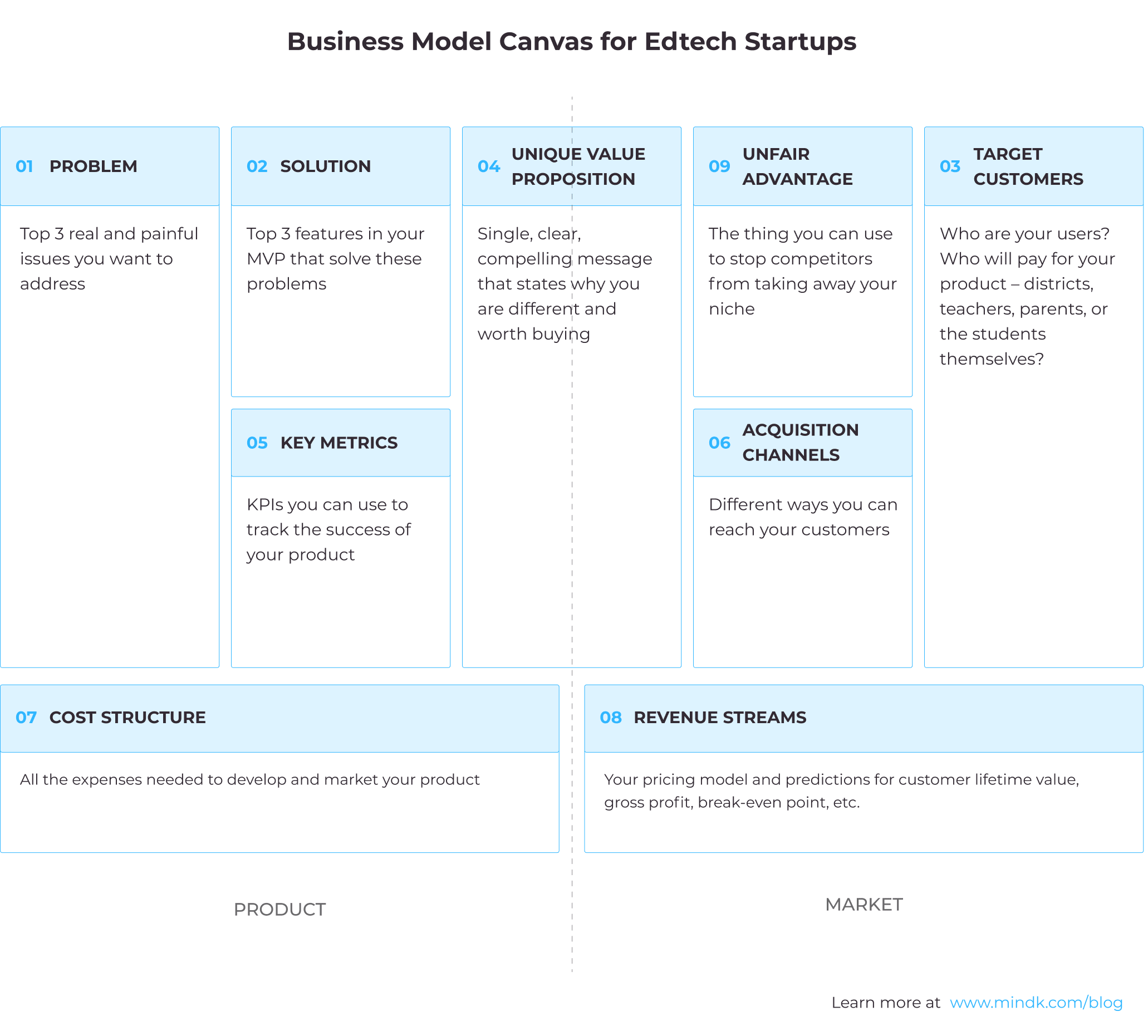
Edtech business model canvas
You can download a blank canvas template to quickly systematize your business model
Freemium (Coursera business model)
Give users a freebie and offer a more advanced plan as an upgrade. What could be easier?
It’s an attractive model for startups as it allows you to establish trust in your brand and quickly become a niche leader.
Initially, Coursera offered free courses on a variety of topics with an option to pay for a certificate. Powered by $210+ million of investments, the company quickly became an edtech powerhouse.
In 2023, Coursera gained 24 million new users.
Introducing a free enterprise tier brought $58.3 million in revenue and attracted thousands of institutions. Yet, Coursera still reported a net loss of $(116.6) million in 2023.
And this leads us to the the two main challenges with the freemium model:
- You will burn through lots of cash acquiring and supporting a large number of free users – marketing alone accounts for 36.5% of Coursera’s revenue.
- You’ll need to somehow convert these free users (and this can be harder than it seems ).
So, is there anything you can do to improve your chances of success?
For starters, you can charge a small one-time payment for your basic plan (aka Cheapium ) to filter out freeloaders and convert users with subscription fatigue.
Or you could go the free trial route (which I’ll explain next, so read on;)
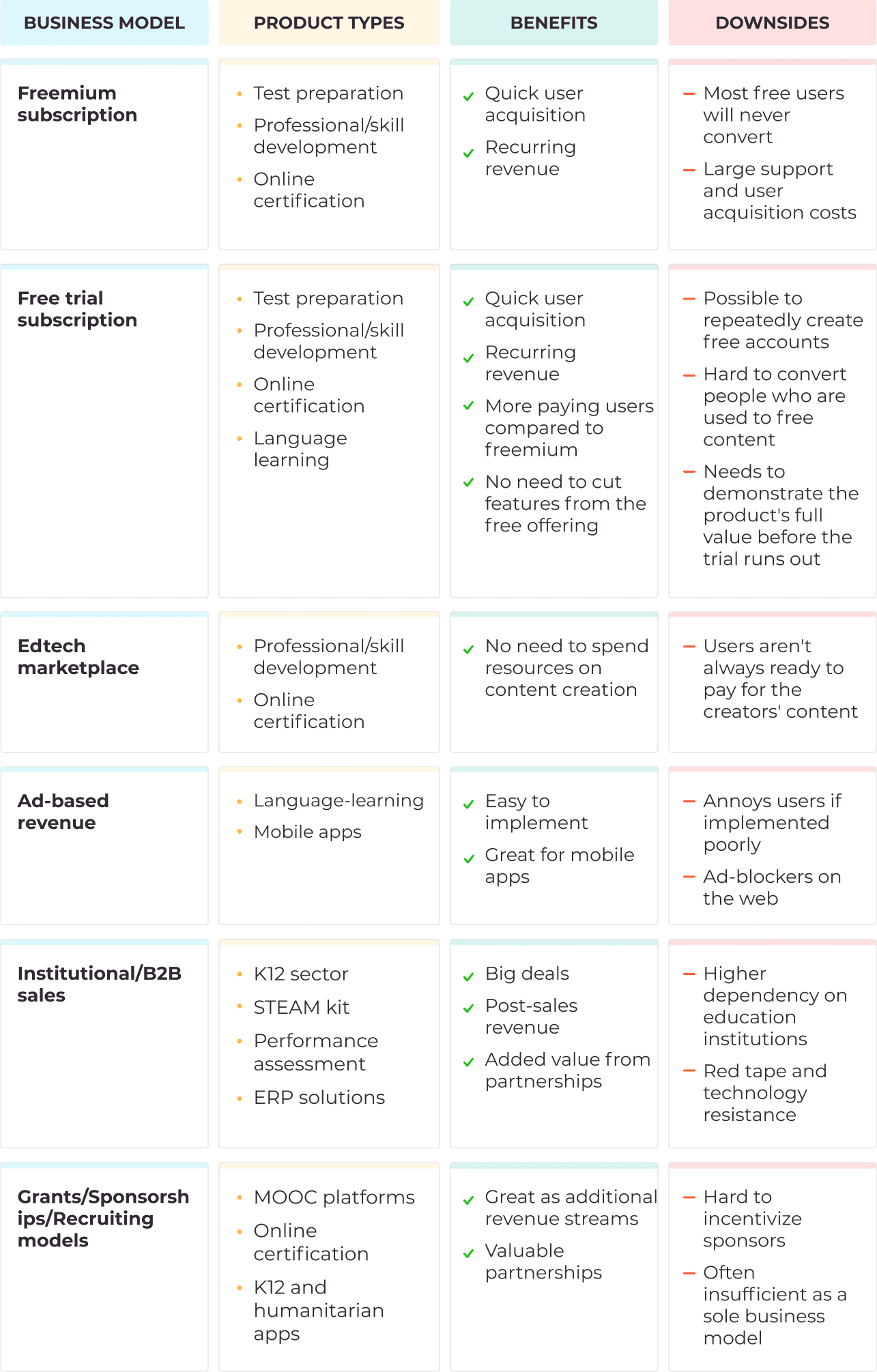
Free trial + paid subscription
This approach is similar to freemium. The only difference is that you offer a complete package right off the bat, but for a short period of time.
After the trial runs out, people either stop using your app or purchase an upgrade. This means that at any point in time, most users will be paying customers generating early revenue, especially, if the trial automatically changes to a paid subscription.
Some users may simply forget to unsubscribe, others will be too lazy. But if you offer a valuable service, most will stay as your loyal customers.
For example, Mystery Science is successfully using the free trial model to help kids fall in love with science. They offer a ton of free lessons on a variety of STEM-related topics.
The company uses a somewhat unusual spin on the free-trial model. Most teachers learn about Mister Science from a friend or a colleague. They can use the product free of charge. At the end of a school year, their school or a district buys a membership for all the teachers.
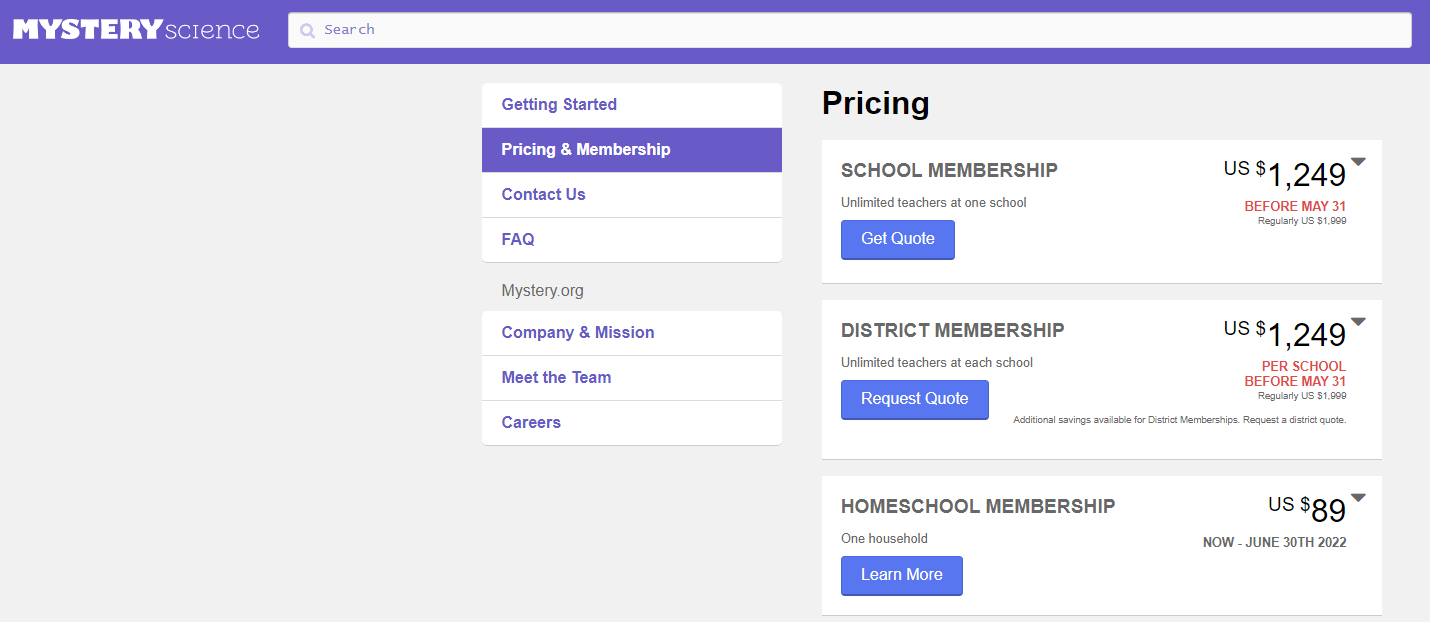
Read more: 7 edtech market trends to keep an eye on in 2024
Edtech marketplace
Few startups have enough resources to produce educational content at scale. This is one of the reasons why edtech marketplace is such a popular business model.
The idea is simple – build a platform where creators can make money from their educational content and take a share of their revenue.
Udemy is one of the world’s most valuable edtech companies, worth $3.3 billion.
The platform hosts thousands of 3rd-party courses from businesses and individuals offering a full set of tools to produce, market, and monetize learning materials.
Posting a course is free but Udemy takes 50% of the creator’s revenue. There are other edtech revenue models you can use, like charging an upfront fee for hosting a course or taking the first $50,000 earned on the platform like edX.
But the marketplace model isn’t only suitable for the edtech giants.
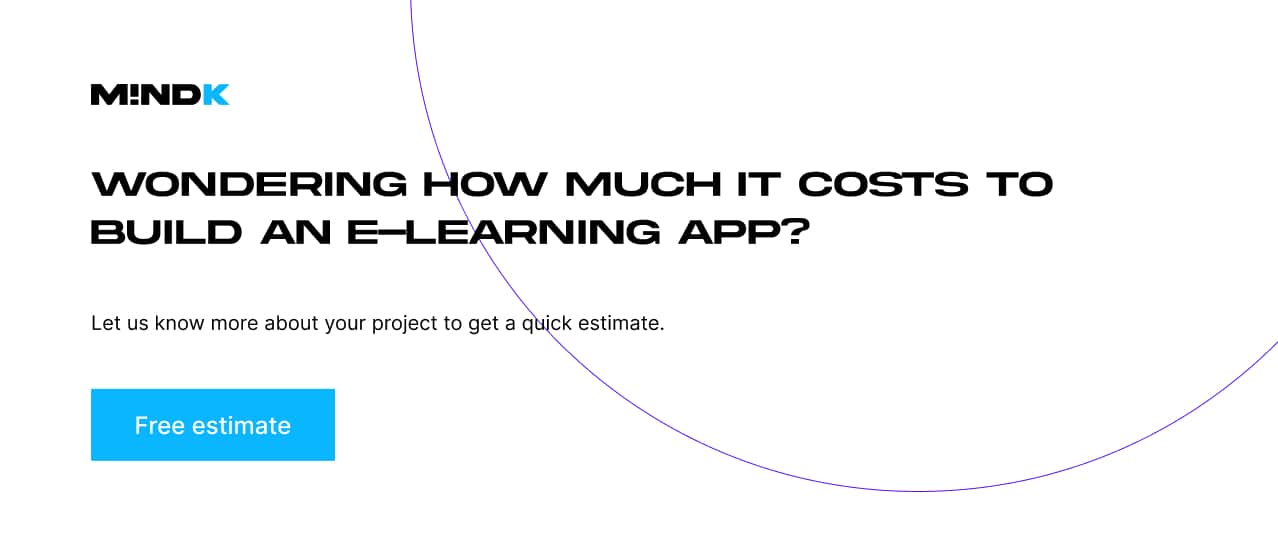
Tyoch Learning is a Luxembourg-based platform that unites coaches, enterprises, and professionals. As a self-funded startup, it couldn’t afford a massive custom platform. Using our experience with existing Learning Management Solutions, our engineers built an MVP that allowed Tyoch to take off.
The platform now hosts a variety of courses in leadership, time management, communication, and professional skills. It has both B2C and B2B models with one-time purchases and enterprise coaching programs.
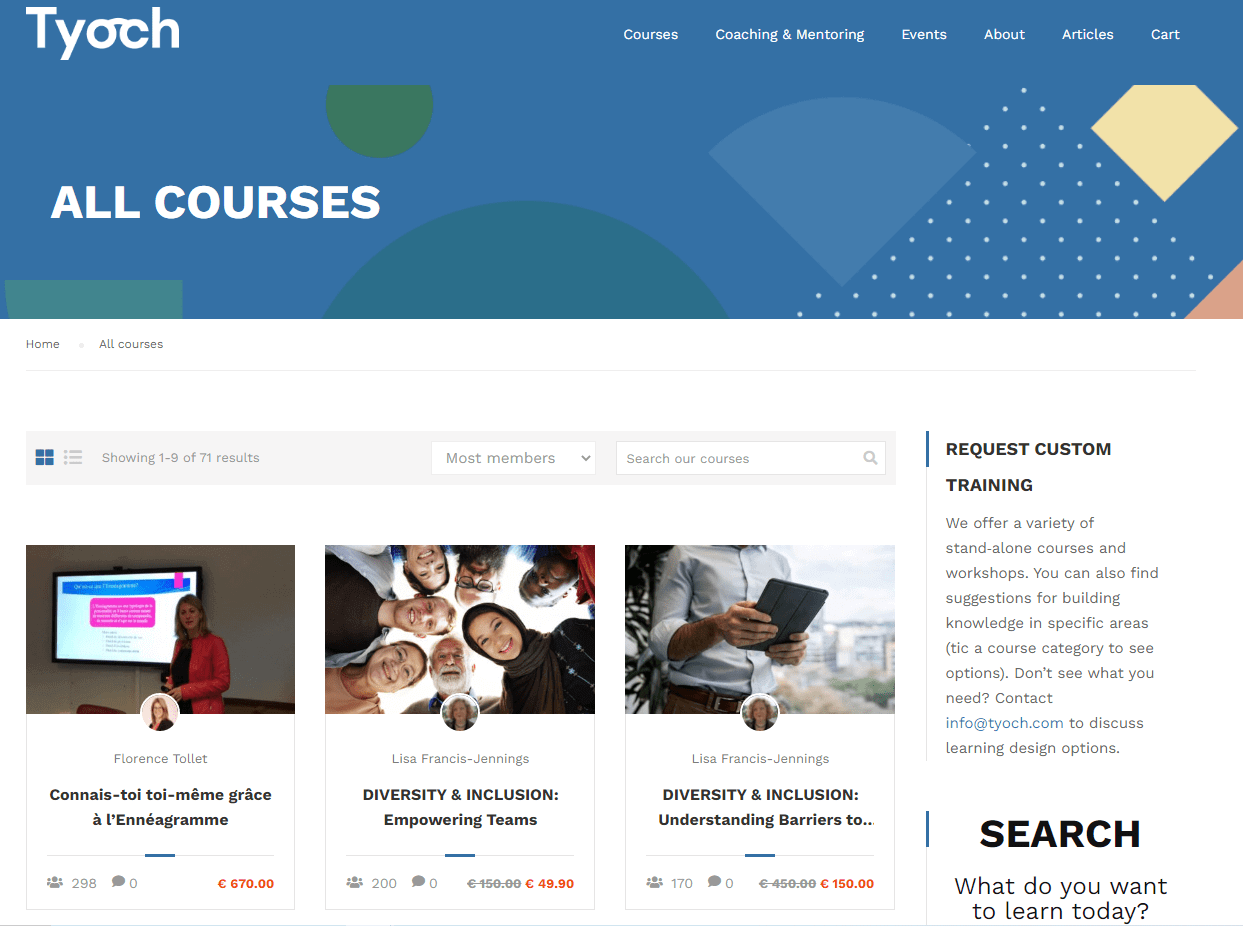
Read more: how to build a Learning Management System using a combination of AI, integrations, custom, and readymade modules.
Advertising + ads-free subscription
Duolingo started back in 2009, when language learning software cost hundreds of dollars apiece.
But the app went with a very different business model. Duolingo planned to provide the service 100% free and charge businesses for user-translated texts.
The company spent its early years growing the user base. They tested every little detail, measured user behavior, experimented with gamification, and iterated to make the app as engaging as possible.
Usage grew at a steady pace, but the startup wasn’t making any money.
In 2013, the company partnered with CNN and BuzzFeed, translating 600+ articles a day.
Over the next few years, Duolingo built a flashcard app called TinyCards and introduced paid language testing which accounts for about 20% of the company’s bottom line.
Yet, these revenue streams were insufficient to make the app profitable. Instead of focusing on the B2B service that was bringing money, the founders went back to the core idea – provide the best way to learn a language, free of charge.
They started showing ads at the end of a lesson with an option to pay for the ads-free experience. Combined, this earned the company $16.6 million of net profit in 2023.
The key to succeeding with an ad-based model is to make it your ads as unobtrusive as possible. User experience is still the king!
Whatever model you choose, Duolingo proves it’s essential to test all your assumptions with real users, experiment in quick iterations, and pivot if necessary.
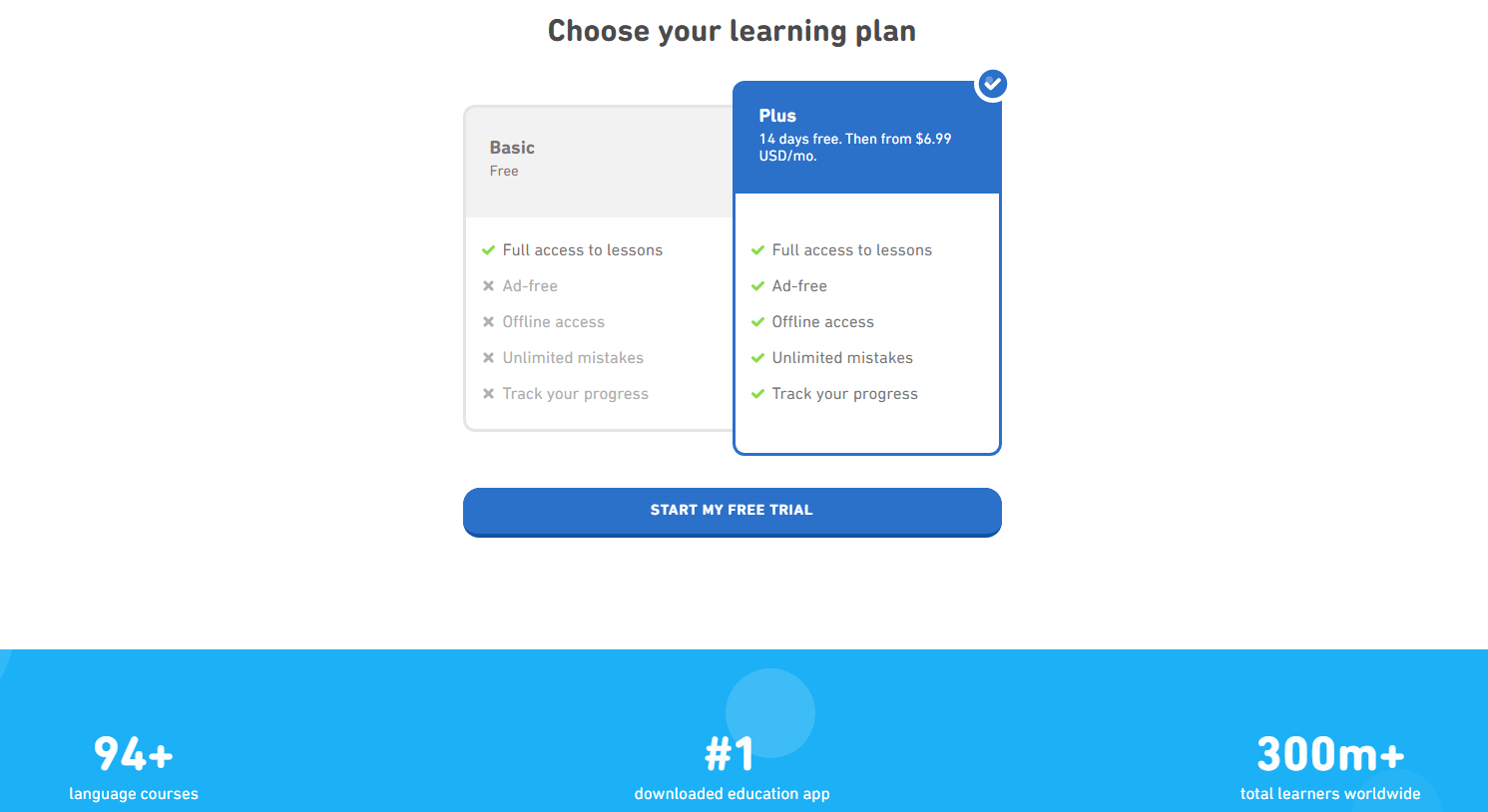
Duolingo Plus combines freemium and free trial models
Institutional model
This is a traditional model for the K12 sector.
The concept is simple – pitch your product to school districts, university administrations, and other decision-makers.
This model can be a winning choice if your product benefits organizations more than individuals. Or if it needs to be integrated into data systems at the district level.
Schoolzilla offers interactive dashboards to 140+ school districts across the US. Its main benefit is better decision-making, which appeals to principals and district admins. So the top-down approach was a natural extension of the product.
However, it’s not a one-fits-all solution.
There are over 16,000 districts in the US alone. Some of them big, some small and there can be large differences in the procurement process.
You can, of course, sell to individual schools instead of districts. According to Y Combinator’s CEO Geoff Ralston, schools now have bigger IT budgets and often employ directors of technology to help with purchasing decisions. Getting to know people those might be the key to your success.
However, to scale effectively, this model might require a large number of people doing the groundwork across the country.
Another challenge is that your end-users (teachers and schoolchildren) are often not your customers (people who pay for your product).
SharpScholar founders had to reboot their product because it had too many approval layers. The buy-in process involved both teachers, admins, and students. This resulted in a lack of focus and muddied positioning.
Their advice is to reduce the layers of approval and maintain a direct relationship with your customers, whoever they may be.
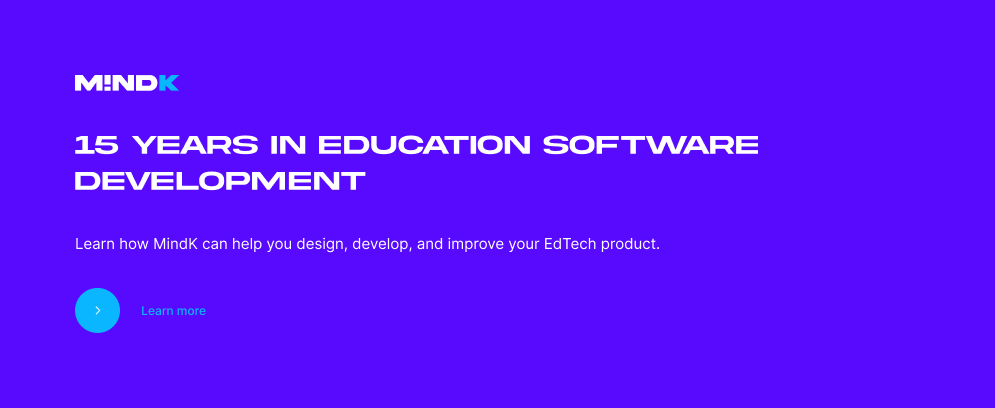
Enterprise/B2B sales
A similar top-down approach works if you work in B2B and association management niches.
Enterprise models involve pitching your product to decision-makers within large organizations. The contracts usually have a fixed duration, designated value, and come with a renewal at the end of the term.
Benefits are two-fold – large deals for some early revenue and long-term partnerships you can use to produce high-value content for the B2C sector.
Udacity is a $1.1 billion unicorn that sells educational courses both to businesses and users. These so-called nano degrees are created in partnership with companies like Google and Amazon. This makes them more attractive for the students and helps the company stand out from the crowd.
The company also has a successful B2B model with on-site training for corporate clients.
By combining different B2C and B2B models, Udacity managed to increase its revenue by 260% in 2020, reaching $100M three years later.
AlreadyOn is a niche player targeting Norwegian communities and associations. They evolved from a pure enterprise model (sell the product to organization leaders as a single transaction) to a more traditional SaaS business.
A self-service portal we built for them can be easily customized for any organization, be it a professional association, a political party, or a business entity.
The subscription is based on the selected modules and the number of members in your system.
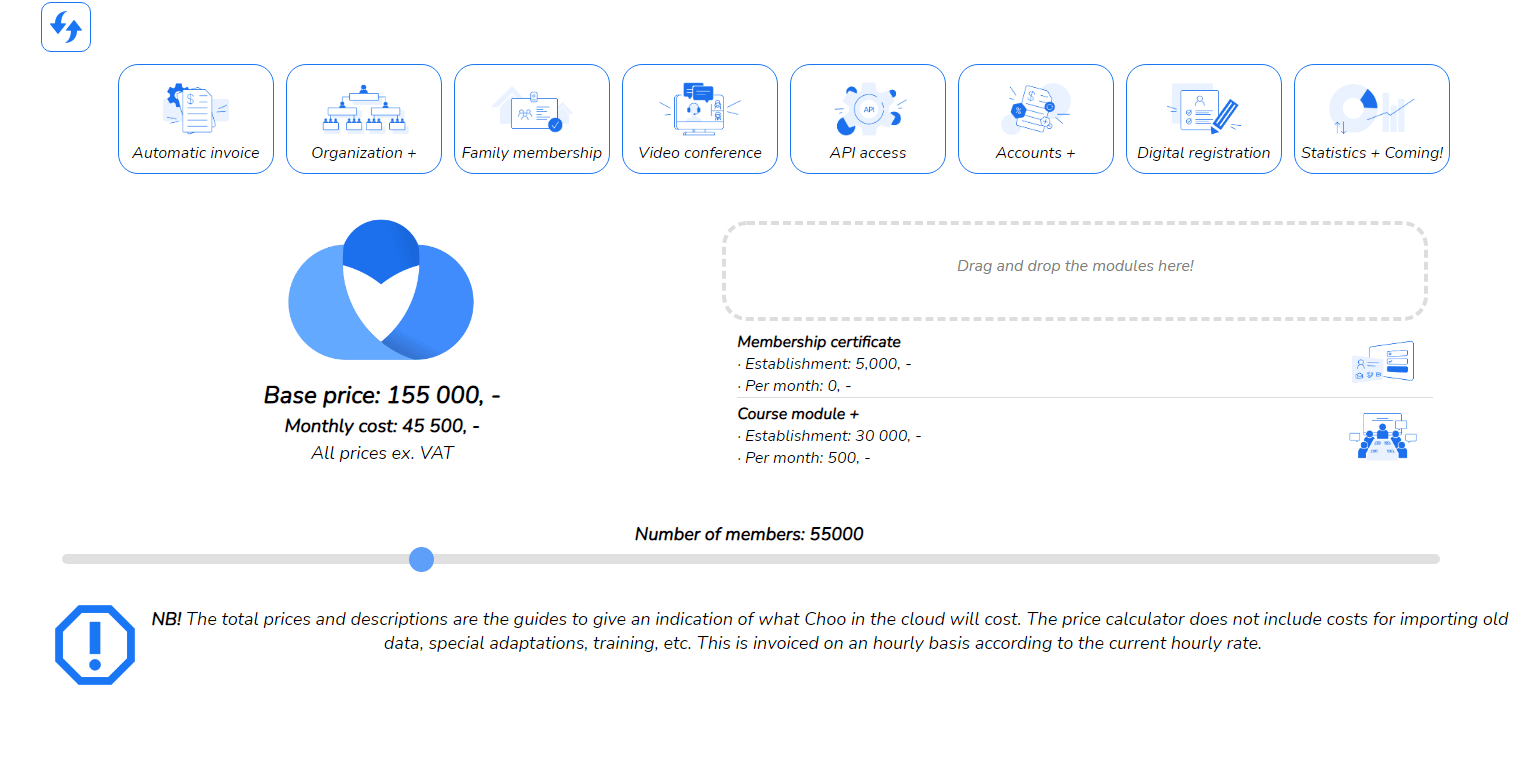
Learn how MindK can help you build a successful edtech business as a custom application development company .
Subscribe to MindK Blog

How to Address Critical Challenges in Custom Enterprise Software Development

How to Increase User Engagement in Your App: 13 Proven Ways

15 key steps to make your software GDPR compliant in 2024
This website uses cookies to improve your user experience. Check our privacy policy here .

IMAGES
VIDEO
COMMENTS
A revenue model gives a business a framework for generating income, and a yardstick by which they can measure their long-term profitability. Understanding the mechanics of a revenue model can help determine a company’s success.
We discuss the cases of Learn@WU, EducaNext, and HCD-Online using a triangulation case study design and present both empirical cost structures and potential revenue models.
1. Introduction to EdTech Revenue Streams. 2. Sustaining Long-Term Growth. 3. Converting Users to Paying Customers. 4. Course Licensing and Content Partnerships. 5. …
A revenue model is the way a business generates income from its products or services. It defines who pays, how much, when, and for what value proposition. A well …
Revenue generation in higher education is a complex system. From the larger external macro-environmental forces to internal administrative improvements and the eternal …
EdTech: Top 5 Target Markets And 7 Popular Business Models. Education technology has grown tremendously in recent years, driven by technological advancements and the growing demand for accessible, …
Choosing your revenue model is a core part of your go-to-market (GTM) strategy. Check out our guide and download a template here. Discover the most popular revenue models for edtech companies and how to choose the …
Dive into revenue generation and explore the key steps you can take to successfully generate and expand revenue for your business by offering online education and courses.
Most of the edtech business models look pretty similar to what you can see in other niches. Yet, there are some specifics you should know. That’s why we detailed the top 7 types of business model for education startups to rock the …